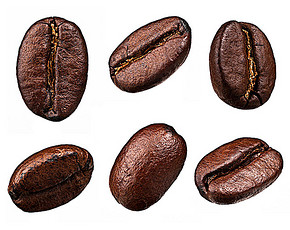Introduction of Huilan planting area in Colombia
Follow the caf é (Wechat official account vdailycom) and found that Beautiful Cafe opened a small shop of its own.
The history of coffee cultivation in Colombia can be traced back to the Spanish colonial era in the 16th century, and there are many theories about the history of coffee in Colombia:
One: it is said to come from the sea island of the Caribbean and from El Salvador in Central America.

Second: in 1808, a priest introduced coffee beans to Colombia for the first time from the French Antilles via Venezuela. One of them is that Colombia's first coffee seeds were imported from Venezuela through the province of Santander.
ADVERTISEMENT number three: the earliest records of coffee cultivation in Colombia appear in a book called "The Illustrated Orinoca" by the Spanish missionary Jose Gumilla. He describes what he saw when he preached on both sides of the Meta River in 1730, in which he mentioned the local coffee plantation. By 1787, other missionaries had spread coffee to other parts of Colombia.
Colombia, located in the northwest of South America, is a beautiful country with a long history. Indians have lived on this land since ancient times. It was colonized by Spain in 1531 and gained independence in 1819. It was renamed in 1886 to commemorate Columbus, the discoverer of the American continent. Colombia has beautiful mountains and rivers, beautiful scenery, pleasant climate, spring all year round and fresh air. Colombia is rich in products, especially coffee, flowers, gold and emeralds are known as the "four treasures". Today, the country is the second largest coffee producer after Brazil, the world's largest exporter of Arabica coffee beans and the world's largest exporter of washed coffee beans. Colombian coffee is often described as silky and smooth. Of all the coffees, it is the most balanced, soft, smooth and ready to drink, and it has won praise that no other coffee can match: known as "green gold".
ADVERTISEMENT Santa Rita Manor
Santa Rita Manor is located in the Colombian province of Antioquia, located in a micro-producing area adjacent to the Andes. This high-quality coffee is made together by nine nearby farms. The nine farms still handle the coffee in the traditional way: picking coffee cherries by hand, then washing the coffee fruits with traditional water, and drying the treated coffee beans in a scaffolding. The environment around the Andes makes this coffee-growing area rich in volcanic soil and rich in water resources.
Mirado Manor
Mirador Manor is located in the southernmost Pitalito (Pitalito) producing area of Huila (Huilan), which is famous for producing high-quality coffee. Elkin Guzman, the owner of the garden, is undoubtedly a pioneer in the coffee industry. The clever young grower uses the latest technology to improve his planting, harvesting and processing techniques. After the coffee cherries are harvested, they will be sifted in the sink and hand-selected before drying the coffee. In the first 8 days, the coffee was dried in the sun on the viaduct and stirred continuously. On the 9th day, the coffee was moved to the dryer to dry for 35 days to avoid excessive temperature affecting the flavor.
ADVERTISEMENT
Millennium Manor
Monsalot is located in the southwest of the Colombian province of Ulla, and most of its farmers grow on a small scale, treating coffee as a staple agricultural product in exchange for cash. The New Millennium Farmers' Association (Grupo Asociativo Productores del Nuevo Milenio) was set up a few years ago to improve the quality of coffee and expect to sell raw beans at higher prices. In addition, in 2005, the United States Agency for International Development (USAID) launched the Colombian boutique coffee program in the city, introducing American boutique raw bean traders to cooperate with the Millennium Farmers' Association. They sent people to Monsalot to participate in coffee production, and knew that farmers were improving their planting techniques and producing better coffee. In the boutique coffee market, they also provided suggestions on how to position and market.
The Farmers' Association has 42 members and can produce about three containers (about 825 bags) of raw coffee beans a year. In order to improve the quality, the New Millennium Peasants' Association continues to recruit new members in Monsalot, hoping to expand the scale of production. In addition, with the assistance of USAID and American traders, they have set up a local cup testing laboratory to teach farmers the method of cup testing, hoping that farmers can pass through the cup to judge the quality of coffee, which will be helpful to coffee production.
ADVERTISEMENT
Diamond Manor
The Diamond Manor of Colombia huila, Colombia, located in the southwest of Colombia, is one of the major coffee growing areas. Because there are famous coffee cultivation places in Huilan area, the names of small areas become brand names and circulate. Although the cultivation conditions in this area are also very good, the cultivation infrastructure of coffee cultivation farm and surrounding conditions is not well developed. It is a great pity that the raw bean drying equipment or washing processing facilities are not perfect. The coffee in Huilan area has a strong taste and heavy texture. In particular, the coffee in Huilan area can be called high-quality coffee with the aroma of nuts, chocolate and caramel and suitable acidity. And caramel and other aromas and appropriate acidity can be called high-end boutique coffee.
Important Notice :
前街咖啡 FrontStreet Coffee has moved to new addredd:
FrontStreet Coffee Address: 315,Donghua East Road,GuangZhou
Tel:020 38364473
- Prev

Introduction to Katim Coffee beans
Following Cafe Review (official Wechat account vdailycom) found that Beautiful Cafe opened a small shop of its own [Katim]. Coffee was planted on a large scale in Yunnan in the mid-1950s, with a planting scale of 4000 hectares at the end of 1997. The province's coffee planting area has reached 7800 hectares. At present, the planting area of the province accounts for 70% of the national area, and the output accounts for 83% of the national area. Yunnan Province
- Next

Colombia Huilan characteristics and introduction
Pay attention to coffee reviews (Weixin Official Accounts vdailycom ) and find a beautiful cafe to open its own shop. Colombia Huila: Located in the southwest of Colombia, it is one of the main coffee growing areas. Because there are famous coffee cultivation sites all over the Huilan area, the names of each small area become brand names and circulate. Although the area
Related
- Detailed explanation of Jadeite planting Land in Panamanian Jadeite Manor introduction to the grading system of Jadeite competitive bidding, Red bid, Green bid and Rose Summer
- Story of Coffee planting in Brenka region of Costa Rica Stonehenge Manor anaerobic heavy honey treatment of flavor mouth
- What's on the barrel of Blue Mountain Coffee beans?
- Can American coffee also pull flowers? How to use hot American style to pull out a good-looking pattern?
- Can you make a cold extract with coffee beans? What is the right proportion for cold-extracted coffee formula?
- Indonesian PWN Gold Mandrine Coffee Origin Features Flavor How to Chong? Mandolin coffee is American.
- A brief introduction to the flavor characteristics of Brazilian yellow bourbon coffee beans
- What is the effect of different water quality on the flavor of cold-extracted coffee? What kind of water is best for brewing coffee?
- Why do you think of Rose Summer whenever you mention Panamanian coffee?
- Introduction to the characteristics of authentic blue mountain coffee bean producing areas? What is the CIB Coffee Authority in Jamaica?

